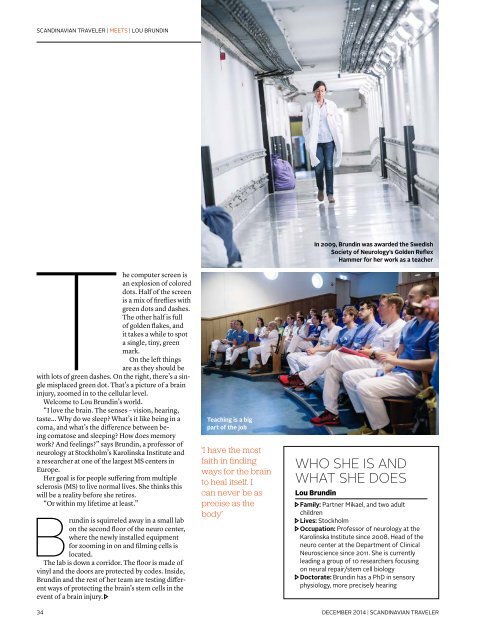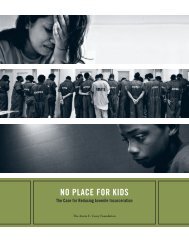st1412_webb
st1412_webb
st1412_webb
You also want an ePaper? Increase the reach of your titles
YUMPU automatically turns print PDFs into web optimized ePapers that Google loves.
SCANDINAVIAN TRAVELER | MEETS | LOU BRUNDIN<br />
T<br />
he computer screen is<br />
an explosion of colored<br />
dots. Half of the screen<br />
is a mix of fireflies with<br />
green dots and dashes.<br />
The other half is full<br />
of golden flakes, and<br />
it takes a while to spot<br />
a single, tiny, green<br />
mark.<br />
On the left things<br />
are as they should be<br />
with lots of green dashes. On the right, there’s a single<br />
misplaced green dot. That’s a picture of a brain<br />
injury, zoomed in to the cellular level.<br />
Welcome to Lou Brundin’s world.<br />
“I love the brain. The senses – vision, hearing,<br />
taste... Why do we sleep What’s it like being in a<br />
coma, and what’s the difference between being<br />
comatose and sleeping How does memory<br />
work And feelings” says Brundin, a professor of<br />
neurology at Stockholm’s Karolinska Institute and<br />
a researcher at one of the largest MS centers in<br />
Europe.<br />
Her goal is for people suffering from multiple<br />
sclerosis (MS) to live normal lives. She thinks this<br />
will be a reality before she retires.<br />
“Or within my lifetime at least.”<br />
B<br />
rundin is squirreled away in a small lab<br />
on the second floor of the neuro center,<br />
where the newly installed equipment<br />
for zooming in on and filming cells is<br />
located.<br />
The lab is down a corridor. The floor is made of<br />
vinyl and the doors are protected by codes. Inside,<br />
Brundin and the rest of her team are testing different<br />
ways of protecting the brain’s stem cells in the<br />
event of a brain injury.<br />
34<br />
Teaching is a big<br />
part of the job<br />
‘I have the most<br />
faith in finding<br />
ways for the brain<br />
to heal itself. I<br />
can never be as<br />
precise as the<br />
body’<br />
In 2009, Brundin was awarded the Swedish<br />
Society of Neurology’s Golden Reflex<br />
Hammer for her work as a teacher<br />
WHO SHE IS AND<br />
WHAT SHE DOES<br />
Lou Brundin<br />
Family: Partner Mikael, and two adult<br />
children<br />
Lives: Stockholm<br />
Occupation: Professor of neurology at the<br />
Karolinska Institute since 2008. Head of the<br />
neuro center at the Department of Clinical<br />
Neuroscience since 2011. She is currently<br />
leading a group of 10 researchers focusing<br />
on neural repair/stem cell biology<br />
Doctorate: Brundin has a PhD in sensory<br />
physiology, more precisely hearing<br />
DECEMBER 2014 | SCANDINAVIAN TRAVELER



